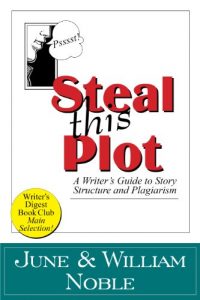This book is not about cemeteries.
Nor is it a mystery-suspense story.
It is about writing—the craft of writing and telling a tale. It is about how to use other people's stories, and what we are allowed to do with them.
The plot of any story is the key. The plot is the story within the story that propels the action and develops the tale. In Hamlet, for instance, the story deals with who will be the rightful king of Denmark, but the plot is concerned with revenge and ambition.
The plot is the nucleus of the action, and it is here that the writer must look to form his efforts.
In Part One, the authors deal in depth with the structuring and “spicing” of the story.
In Part Two, using classic and modern examples they outline 13 common plot movers:
Vengeance
Catastrophe
Love and Hate
The Chase
Grief and Loss
Rebellion
Betrayal
Persecution
Self-Sacrifice
Survival
Rivalry
Discovery (Quest)
Ambition
showing you how weave it all together in a tapestry of words rich and satisfying to the reader.
Worried you’ll go too far in your plot thievery? A thorough look at plagiarism and copyright is also included.
_________
“I used the suggestions from this book to write both my published novels.” —Wesley C. Greayer, author of The Tornado Struck at Midnight
“Steal this book if necessary, but get it onto your shelf of writers' indispensable books.” —Kenneth J. Atchity, writer, producer, teacher, and literary manager
Nor is it a mystery-suspense story.
It is about writing—the craft of writing and telling a tale. It is about how to use other people's stories, and what we are allowed to do with them.
The plot of any story is the key. The plot is the story within the story that propels the action and develops the tale. In Hamlet, for instance, the story deals with who will be the rightful king of Denmark, but the plot is concerned with revenge and ambition.
The plot is the nucleus of the action, and it is here that the writer must look to form his efforts.
In Part One, the authors deal in depth with the structuring and “spicing” of the story.
In Part Two, using classic and modern examples they outline 13 common plot movers:
Vengeance
Catastrophe
Love and Hate
The Chase
Grief and Loss
Rebellion
Betrayal
Persecution
Self-Sacrifice
Survival
Rivalry
Discovery (Quest)
Ambition
showing you how weave it all together in a tapestry of words rich and satisfying to the reader.
Worried you’ll go too far in your plot thievery? A thorough look at plagiarism and copyright is also included.
_________
“I used the suggestions from this book to write both my published novels.” —Wesley C. Greayer, author of The Tornado Struck at Midnight
“Steal this book if necessary, but get it onto your shelf of writers' indispensable books.” —Kenneth J. Atchity, writer, producer, teacher, and literary manager






